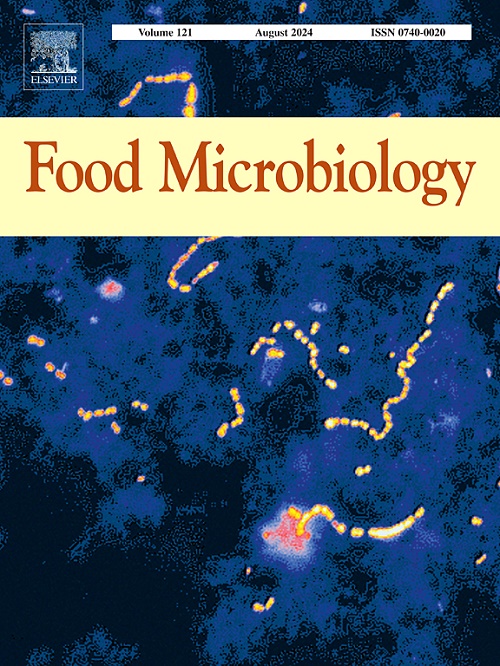使用等离子活化水对禽舍常见建筑表面的沙门氏菌属进行净化
IF 4.5
1区 农林科学
Q1 BIOTECHNOLOGY & APPLIED MICROBIOLOGY
引用次数: 0
摘要
等离子活化水(PAW)已被证明具有抗菌特性,是一种很有前途的表面净化工具。本研究评估了高压大气冷等离子体生成的等离子活化水去除禽舍常见表面(不锈钢 (SS)、聚氯乙烯 (PVC)、混凝土和木材)沙门氏菌的能力。将蒸馏水暴露于 80% 潮湿空气中的常压冷等离子体中,在 90 千伏和 60 赫兹的条件下持续 30 分钟,即可产生 PAW。生成的 PAW 含有 1120 ppm 的硝酸盐和 1370 ppm 的过氧化氢,pH 值为 1.83。然后将 PAW 应用于 SS、PVC、木材和混凝土表面接种了 7-8 log10 CFU 鸡尾酒沙门氏菌属(鼠伤寒沙门氏菌、新港沙门氏菌、蒙得维的亚沙门氏菌和肠炎沙门氏菌)的试样。在木材表面,需要更长的处理时间(7.5 分钟)才能最大减少 2.63 log10 CFU,这可能是由于木材的多孔性限制了 PAW 与细菌的接触。在混凝土表面,沙门氏菌的数量仅减少了 0.98 log10 CFU。这可能是由于表面粗糙度较大,碱度较高,从而中和了 PAW 菌种。本文章由计算机程序翻译,如有差异,请以英文原文为准。
Using plasma-activated water for decontamination of Salmonella spp. on common building surfaces in poultry houses
Plasma-activated water (PAW) has been shown to have antimicrobial properties, making it a promising tool for surface decontamination. This study evaluated the ability of PAW generated from high voltage atmospheric cold plasma to remove Salmonella from common surfaces (stainless steel (SS), polyvinyl chloride (PVC), concrete, and wood) found in poultry houses. PAW was generated by exposing distilled water to atmospheric cold plasma in 80% humid air at 90 kV and 60 Hz for 30 min. The resulting PAW contained 1120 ppm of nitrate and 1370 ppm of hydrogen peroxide, with a pH of 1.83. PAW was then applied to coupons of SS, PVC, wood, and concrete surfaces inoculated with 7–8 log10 CFU of cocktail of Salmonella spp. (S. Typhimurium, S. Newport, S. Montevideo, and S. Enteritidis). PAW effectively reduced Salmonella levels on SS and PVC surfaces to below the detection limit within 30 s. On wood surfaces, a longer treatment time of 7.5 min was required to achieve a maximum reduction of 2.63 log10 CFU, likely due to the porosity of the wood limiting PAW contact with the bacteria. On concrete surfaces, the reduction in Salmonella levels was only 0.98 log10 CFU. This was likely due to the greater surface roughness and high alkalinity, which neutralized the PAW species.
求助全文
通过发布文献求助,成功后即可免费获取论文全文。
去求助
来源期刊

Food microbiology
工程技术-生物工程与应用微生物
CiteScore
11.30
自引率
3.80%
发文量
179
审稿时长
44 days
期刊介绍:
Food Microbiology publishes original research articles, short communications, review papers, letters, news items and book reviews dealing with all aspects of the microbiology of foods. The editors aim to publish manuscripts of the highest quality which are both relevant and applicable to the broad field covered by the journal. Studies must be novel, have a clear connection to food microbiology, and be of general interest to the international community of food microbiologists. The editors make every effort to ensure rapid and fair reviews, resulting in timely publication of accepted manuscripts.
 求助内容:
求助内容: 应助结果提醒方式:
应助结果提醒方式:


